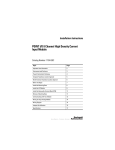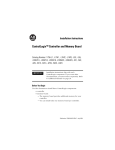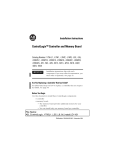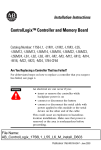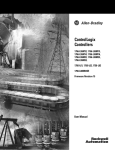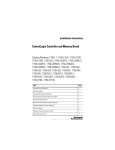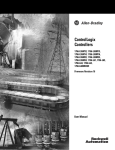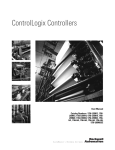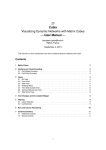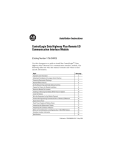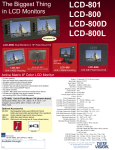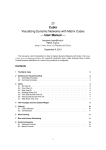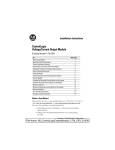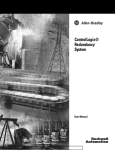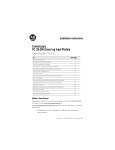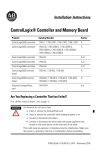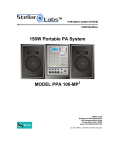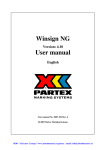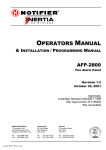Download ControlLogix™ Memory Board
Transcript
Installation Instructions ControlLogix™ Memory Board Catalog Number: 1756-M1, -M2, -M3, -M13, -M14, -M16 Before You Begin Use this document as a guide to install your ControlLogix memory board. The memory board privides additional memory for your ControlLogix controller. You can install only one memory board per controller. Additional Manuals This product has the following manuals: • Logix5000 Controllers Common Procedures Programming Manual, publication 1756-PM001 • ControlLogix System User Manual, publication 1756-UM001 If you want to: • view or download a manual, visit either of these locations: – www.ab.com/manuals – www.theautomationbookstore.com • purchase a printed manual, use one of these options: – contact your local distributor or Rockwell Automation representative – visit www.theautomationbookstore.com and place an order – call 800.963.9548 (USA/Canada) or 001.320.725.1574 (outside USA/Canada) Tools that You Need • #2 phillips screwdriver • grounding wriststrap Publication 1756-IN033B-EN-P - November 2000 2 ControlLogix™ Memory Board Important User Information Because of the variety of uses for the products described in this publication, those responsible for the application and use of this control equipment must satisfy themselves that all necessary steps have been taken to assure that each application and use meets all performance and safety requirements, including any applicable laws, regulations, codes and standards. The illustrations, charts, sample programs and layout examples shown in this guide are intended solely for purposes of example. Since there are many variables and requirements associated with any particular installation, Allen-Bradley does not assume responsibility or liability (to include intellectual property liability) for actual use based upon the examples shown in this publication. Allen-Bradley publication SGI-1.1, Safety Guidelines for the Application, Installation and Maintenance of Solid-State Control (available from your local Allen-Bradley office), describes some important differences between solid-state equipment and electromechanical devices that should be taken into consideration when applying products such as those described in this publication. Reproduction of the contents of this copyrighted publication, in whole or part, without written permission of Rockwell Automation, is prohibited. Throughout this manual we use notes to make you aware of safety considerations: ATTENTION Identifies information about practices or circumstances that can lead to personal injury or death, property damage or economic loss ! Attention statements help you to: • identify a hazard • avoid a hazard • recognize the consequences IMPORTANT Identifies information that is critical for successful application and understanding of the product. Allen-Bradley and ControlLogix are trademarks of Rockwell Automation. Publication 1756-IN033B-EN-P - November 2000 ControlLogix™ Memory Board 3 European Communities (EC) Directive Compliance If this product has the CE mark it is approved for installation within the European Union and EEA regions. It has been designed and tested to meet the following directives. EMC Directive This product is tested to meet the Council Directive 89/336/EC Electromagnetic Compatibility (EMC) by applying the following standards, in whole or in part, documented in a technical construction file: • EN 50081-2 EMC — Generic Emission Standard, Part 2 — Industrial Environment • EN 50082-2 EMC — Generic Immunity Standard, Part 2 — Industrial Environment This product is intended for use in an industrial environment. Low Voltage Directive This product is tested to meet Council Directive 73/23/EEC Low Voltage, by applying the safety requirements of EN 61131-2 Programmable Controllers, Part 2 Equipment Requirements and Tests. For specific information required by EN 61131-2, see the appropriate sections in this publication, as well as the Allen-Bradley publication Industrial Automation Wiring and Grounding Guidelines, publicaton 1770-4.1. Open style devices must be provided with environmental and safety protection by proper mounting in enclosures designed for specific application conditions. See NEMA Standards publication 250 and IEC publication 529, as applicable, for explanations of the degrees of protection provided by different types of enclosure. Publication 1756-IN033B-EN-P - November 2000 4 ControlLogix™ Memory Board What You Need to Do To guard against ESD damage, take these precautions: ATTENTION ! Electrostatic discharge can damage the components. Follow these guidelines: • • • • • • touch a grounded object to discharge potential static wear an approved grounding wriststrap do not touch connectors or pins on component boards do not touch circuit components inside the controller if available, use a static-safe work station when not in use, store each component in the anti-static packaging in which it was shipped To install the memory board, do these steps: • Step 1: Verify that You Have All the Components • Step 2: Remove the Controller from the Chassis • Step 3: Remove the Side Plate of the Controller • Step 4: Remove the Existing Memory Board (If Any) • Step 5: Install the Memory Board • Step 6: Replace the Side Plate • Step 7: Attach Labels Publication 1756-IN033B-EN-P - November 2000 ControlLogix™ Memory Board 5 Step 1: Verify that You Have All the Components A. Locate the following components: Component: Description: memory board 40042 memory board label catalog number labels 1756-L1 1756-L1M1 The catalog numbers on your labels may be different from the ones that are shown. 1756-L1M2 B. Make sure that you have the correct memory board: If you have this controller: Then you can: 1756-L1 add one of these memory boards: • 1756-M1 • 1756-M2 • 1756-M3 1756-L1Mx replace the existing memory board with one of these memory boards: • 1756-M1 • 1756-M2 • 1756-M3 1756-L55Mx replace the existing memory board with one of these memory boards: • 1756-M13 • 1756-M14 • 1756-M16 Publication 1756-IN033B-EN-P - November 2000 6 ControlLogix™ Memory Board Step 2: Remove the Controller from the Chassis You can install or remove a ControlLogix controller while chassis power is applied and the system is operating. If you remove the controller, all the devices owned by the controller go to their configured faulted state. WARNING ! When you insert or remove a module while backplane power is on, an electrical arc may occur. An electrical arc can cause personal injury or property damage by: • sending an erroneous signal to your system’s actuators causing unintended machine motion or loss of process control • causing an explosion in a hazardous environment Repeated electrical arcing causes excessive wear to contacts on both the module and its mating connector. Worn contacts may create electrical resistance that can affect module operation. A. On the top and bottom of the controller, press the locking tabs. B. Slide the controller out of the chassis. 20880 Publication 1756-IN033B-EN-P - November 2000 ControlLogix™ Memory Board 7 Step 3: Remove the Side Plate of the Controller A. Lay the controller on its side with the label facing up. B. While wearing a grounding wriststrap, remove the two screws that attach the side plate to the controller. C. Rotate the side plate up and unhook it from the controller. side plate front of controller 40017 Publication 1756-IN033B-EN-P - November 2000 8 ControlLogix™ Memory Board Step 4: Remove the Existing Memory Board (If Any) memory board 42527 Does the controller already have a memory board? If: Then: No Go to Step 5: Install the Memory Board Yes Remove the existing memory board: 1. Pull the plastic back edge of the controller out slightly to clear the tabs on the memory board. tab tab 42526 2. Gently separate and remove the memory board from the controller. Publication 1756-IN033B-EN-P - November 2000 ControlLogix™ Memory Board 9 Step 5: Install the Memory Board memory board tab tab slot slot 40018 A. Place the memory board over the connector and slide the memory board into the controller. B. Pull the plastic back edge of the controller out slightly to clear the tabs of the memory board. C. Line up the connectors. D. Place your hands on the boards over the connectors and gently squeeze them together. E. Make sure that the tabs on the memory board extend through the slots on the plastic housing of the controller. Publication 1756-IN033B-EN-P - November 2000 10 ControlLogix™ Memory Board Step 6: Replace the Side Plate side plate 40019 A. Line up the hinge tabs on the side plate with the slots in the plastic housing of the controller. B. Gently press the side plate against the controller. C. Replace the screws. Publication 1756-IN033B-EN-P - November 2000 ControlLogix™ Memory Board 11 Step 7: Attach Labels A. 40019 A. Place the memory board label on the side of the controller. It identifies which memory board is installed. B. From the sheet of catalog labels, peel off the label that corresponds to the memory board that you installed. (E.g., If you installed an M2 memory board, peel off the 1756-L1M2 label.) 1756-L1 1756-L1M1 1756-L1M2 identifies the memory board 1756-LxMx 41025 C. Place the catalog number label on the inside of the controller door. Publication 1756-IN033B-EN-P - November 2000 12 ControlLogix™ Memory Board Agency Certifications When marked, the controller and memory board have the following certifications: This component: Has these certifications (when the product is marked): 1756-L1 controller 1756-L55 controller Listed Industrial Control Equipment Certified Process Control Equipment Certified Class I, Division 2, Group A, B, C, D Marked for all applicable directives Marked for all applicable acts N223 1756-Mx memory board UL Recognized Component Industrial Control Equipment Certified component Process Control Equipment Certified component Class I, Division 2, Group A, B, C, D Marked for all applicable directives Marked for all applicable acts N223 Publication 1756-IN033B-EN-P - November 2000 ControlLogix™ Memory Board 13 Specifications Table A 1756-L1, -L1Mx Controller Description: user available memory Value: (1) peak backplane current +5V dc +24V dc 1756-L1 1756-L1M1 1756-L1M2 1756-L1M3 64K bytes 512K bytes 1M bytes 2M bytes 0.65A 0.02A 0.95A 0.02A 1.05A 0.02A 1.20A 0.02A average power dissipation 3.3W 4.6W 4.8W 5.4W average thermal dissipation 11.3 BTU/hr 15.6 BTU/hr 16.4 BTU/hr 18.4 BTU/hr operating temperature 0° to 60° C (32 to 140° F) storage temperature -40° to 85° C (-40 to 185° F) relative humidity 5% to 95% noncondensing vibration 10 to 500 Hz 2.0 G maximum peak acceleration operating shock 30G peak for 11ms storage shock 50G peak for 11ms additional environmental requirements • This product must be mounted within a suitable enclosure to prevent personal injury resulting from accessibility to live parts. The interior of this enclosure must be accessible only by use of a tool. • This industrial control equipment is intended to operate in a Pollution Degree 2 environment, in overvoltage category II applications, (as defined in IEC publication 664A) at altitudes up to 2000 meters without derating. weight 10.0 oz. programming cable 1756-CP3 or 1747-CP3 serial cable category 3(2) battery 1756-BA1 (PROMARK Electronics 94194801) 0.59g lithium documentation set 1756-DPALEN (1) (2) 12.5 oz. 12.5 oz. 12.7 oz. Amount of memory available after RSLogix 5000 software is connected and a null project is loaded See Industrial Automation Wiring and Grounding Guidelines, publicaton 1770-4.1. Publication 1756-IN033B-EN-P - November 2000 14 ControlLogix™ Memory Board Table B 1756-L55Mxx Controller Description: Value: 1756-L55M13 1756-L55M14 1756-L55M16 user available memory(1) 1.5M bytes 3.5M bytes 7.5M bytes peak backplane current +5V dc +24V dc 1.23A 0.014A 1.25A 0.014A 1.48A 0.014A average power dissipation 5.6W 5.7W 6.3W average thermal dissipation 19.1 BTU/hr 19.4 BTU/hr 21.5 BTU/hr operating temperature 0° to 60° C (32 to 140° F) storage temperature -40° to 85° C (-40 to 185° F) relative humidity 5% to 95% noncondensing vibration 10 to 500 Hz 2.0 G maximum peak acceleration operating shock 30G peak for 11ms storage shock 50G peak for 11ms additional environmental requirements • This product must be mounted within a suitable enclosure to prevent personal injury resulting from accessibility to live parts. The interior of this enclosure must be accessible only by use of a tool. • This industrial control equipment is intended to operate in a Pollution Degree 2 environment, in overvoltage category II applications, (as defined in IEC publication 664A) at altitudes up to 2000 meters without derating. weight 12.5 oz. programming cable 1756-CP3 or 1747-CP3 serial cable category 3(2) battery 1756-BA1 (PROMARK Electronics 94194801) 0.59g lithium documentation set 1756-DPALEN (1) (2) 12.8 oz. 13.4 oz. Amount of memory available after RSLogix 5000 software is connected and a null project is loaded See Industrial Automation Wiring and Grounding Guidelines, publicaton 1770-4.1. Publication 1756-IN033B-EN-P - November 2000 ControlLogix™ Memory Board 15 Hazardous Location information The following information applies when operating this equipment in hazardous locations: Products marked “CL I, DIV 2, GP A, B, C, D” are suitable for use in Class I Division 2 Groups A, B, C, D, Hazardous Locations and nonhazardous locations only. Each product is supplied with markings on the rating nameplate indicating the hazardous location temperature code. When combining products within a system, the most adverse temperature code (lowest “T” number) may be used to help determine the overall temperature code of the system. Combinations of equipment in your system are subject to investigation by the local Authority Having Jurisdiction at the time of installation. WARNING ! EXPLOSION HAZARD • Do not disconnect equipment unless power has been removed or the area is known to be nonhazardous. • Do not disconnect connections to this equipment unless power has been removed or the area is known to be nonhazardous. Secure any external connections that mate to this equipment by using screws, sliding latches, threaded connectors, or other means provided with this product. • Substitution of components may impair suitability for Class I, Division 2. • If this product contains batteries, they must only be changed in an area known to be nonhazardous. Publication 1756-IN033B-EN-P - November 2000 Informations sur l’utilisation de cet équipement en environnements dangereux : Les produits marqués « CL I, DIV 2, GP A, B, C, D » ne conviennent qu’à une utilisation en environnements de Classe I Division 2 Groupes A, B, C, D dangereux et non dangereux. Chaque produit est livré avec des marquages sur sa plaque d’identification qui indiquent le code de température pour les environnements dangereux. Lorsque plusieurs produits sont combinés dans un système, le code de température le plus défavorable (code de température le plus faible) peut être utilisé pour déterminer le code de température global du système. Les combinaisons d’équipements dans le système sont sujettes à inspection par les autorités locales qualifiées au moment de l’installation. AVERTISSEMENT ! RISQUE D’EXPLOSION • Couper le courant ou s’assurer que l’environnement est classé non dangereux avant de débrancher l’équipement. • Couper le courant ou s’assurer que l’environnement est classé non dangereux avant de débrancher les connecteurs. Fixer tous les connecteurs externes reliés à cet équipement à l’aide de vis, loquets coulissants, connecteurs filetés ou autres moyens fournis avec ce produit. • La substitution de composants peut rendre cet équipement inadapté à une utilisation en environnement de Classe 1, Division 2. • S’assurer que l’environnement est classé non dangereux avant de changer les piles. Publication 1756-IN033B-EN-P - November 2000 Supersedes Publication 1756-5.33 - June 1998 PN 957400-63 © 2000 Rockwell International Corporation. Printed in the U.S.A.
















